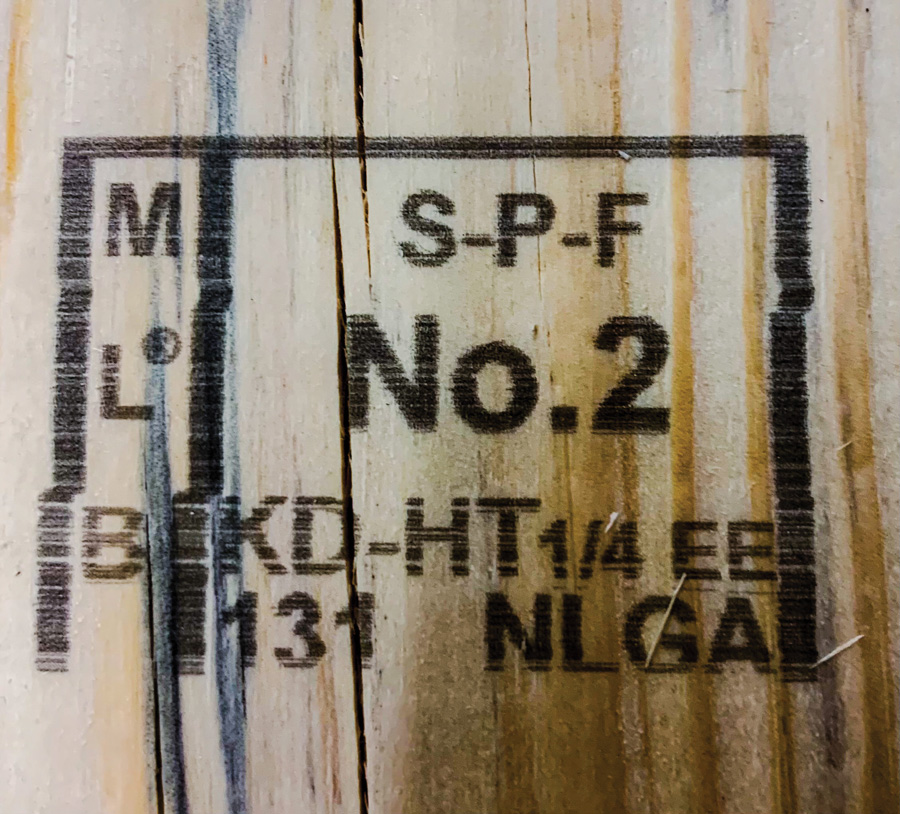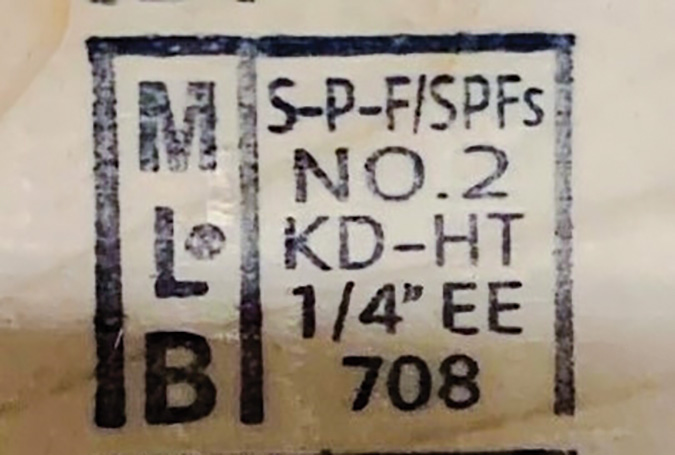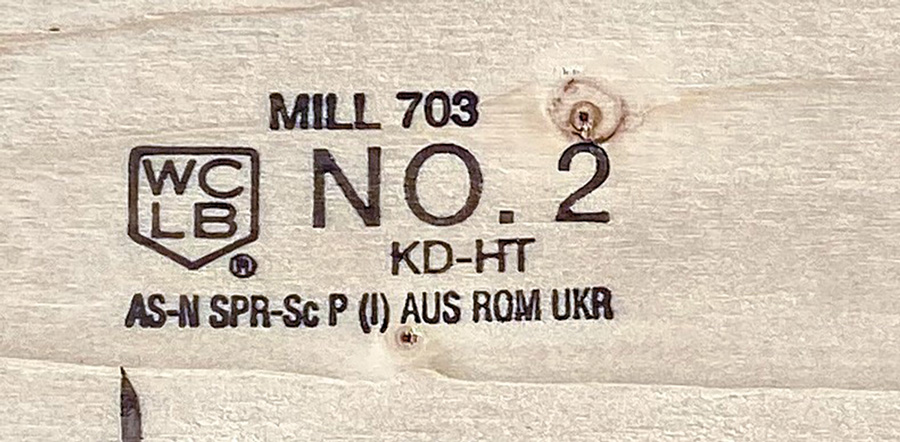It is more important than ever due to the increase in grade-marked products entering the U.S.
Registered design professionals (RDPs) typically specify in their construction documents the assumed lumber grade, moisture content, and species or species combination of the dimension lumber (2-4 inches thick) used in their design work. For example, in the materials section of the construction documents, a note might state:
All wall and floor framing shall be (minimum) No.2 S-DRY Douglas Fir. Roof framing shall be pre-manufactured wood trusses.
This article aims to explain the practical importance of a more robust lumber specification and why it is more important than before due to additional grade-marked products entering the U.S. from other countries over the past 20 years. Further, North American grading agencies are also grade-marking lumber with multiple species or species combinations. As a result, a simple layman’s description may no longer clearly communicate to other parties what products and associated design values were assumed and used by the RDP in their design.
Background
RDPs rely on the Supplement to the National Design Specification® (NDS®) for Wood Construction: Design Values for Wood Construction (NDS Supplement) for the lumber design values assumed for their designs. The 1991 and 1997 NDS Supplement had three tables for dimension lumber:
Table 4A Base Design Values for Visually Graded Dimension Lumber (all except Southern Pine)
Table 4B Base Design Values for Visually Graded Southern Pine Dimension Lumber
Table 4C Design Values for Mechanically Graded Dimension Lumber
For the lumber species or species combinations referenced in Tables 4A, 4B, and 4C, base design values are associated with a typical lumber specification. For example, for any species or species combination and grade, the tabulated design values in the 1997 NDS Supplement are as follows:
Fb = tabulated bending design value, psi
Ft = tabulated tension parallel to grain design value, psi
Fv = tabulated shear parallel to grain design value, psi
Fc = tabulated compression perpendicular to grain design value, psi
Fc = tabulated compression parallel to grain design value, psi, and
E = tabulated modulus of elasticity, psi.
An additional lumber property for the design of fasteners (such as nails, screws, bolts) and connectors, Specific Gravity (G), was tabulated for all species combinations in Table 8A of the 1997 NDS.
In the 2001 edition of the NDS Supplement, a new Table 4F was added to facilitate the design process when specifying visually graded dimension lumber from other than North American countries (historically, U.S. and Canada):
Table 4F. Base Design Values for Non-North American Visually Graded Dimension Lumber (2”-4” thick)
With one exception, the species names included in the new Table 4F differed from U.S. species. Thus, the potential for a miscommunication of what was used and specified by the RDP was minuscule.
By the time of publication of the 2018 NDS Supplement, the number of Non-North American species and species combinations had increased and included species and species combinations with a different grade-mark format comprising multiple lumber products (https://awc.org/wp-content/uploads/2022/02/AWC-2018NDS-Supplement-Updates-Errata_22-2-25.pdf). The traditional grade mark applies to one lumber product that includes a single specie or a species combination. For example, the No.2 KD-HT S-P-F grade mark shown in Figure 1 represents one species combination comprised of eight individual species — Alpine Fir, Balsam Fir, Black Spruce, Engelmann Spruce, Jack Pine, Lodgepole Pine, Red Spruce, and White Spruce. Reference design values for the Spruce-Pine-Fir (S-P-F) combination are given in the 2018 NDS Supplement, Table 4A.

As shown in the recently developed Table 4G of an Addendum to the 2018 NDS Supplement (link above), a new grade mark format can include two or more products from two or more countries. For example, a grade mark representing the species combination Spruce-Pine-Fir from Canada (S-P-F) and Spruce-Pine-Fir from the U.S. (SPFS) is shown in Figure 2. The design values that apply to this grade mark can be found in the 2018 NDS Supplement Addendum Table 4G.

Another grade mark example representing three products from Austria, Romania, and Ukraine is shown in Figure 3. The design values that apply to this grade mark can also be found in the 2018 NDS Supplement Addendum Table 4G.

Codes and Standards
For the International Residential Code (IRC) and International Building Code (IBC), traditional lumber species or species combinations and newer sources are listed in the NDS Supplement’s applicable version (Tables 4A, 4B, 4C, 4F, and 4G). In addition, they are required to be manufactured following American Softwood Lumber Standard PS 20 and the grading rules of an approved lumber rules-writing agency. PS 20 (http://alsc.org/uploaded/PS%2020-20%20Revsion%201%20October%202021.pdf) is the referenced standard for lumber in both the IRC and IBC.
For lumber products grade marked with multiple species or species combinations (as demonstrated in Figures 2-3), the reference design values are governed by the new NDS Supplement Table 4G. Due to the way the design values were derived for products included in Table 4G, the tabulated design values are at least as conservative as the design values for products included in Tables 4A, 4B, 4C, and 4F. Since imported lumber is manufactured and graded under that same product standard, grading rules, and supervisory agencies as U.S. lumber, RDPs and regulatory agencies should be comfortable using and recognizing the additional new resource of structural dimension lumber (2-4 inches thick, 2 inches & wider) included in Table 4G.
In summary, the common specification format used in construction documents, such as “All framing lumber shall be No. 2 Southern Pine (or Douglas Fir)”, does not have sufficient detail to differentiate between design values for the traditional U.S. and Canadian lumber products versus imported species or species combination products that are now available. The additional supply of lumber from countries other than the U.S. and Canada motivates rethinking how RDPs can clearly specify dimension lumber in their structural construction documents.
Robust Lumber Specifications
A robust lumber specification should document the lumber grades, species or species combinations, and associated design values used in the structural design. In addition, the specification should include sufficient detail whereby the description incorporates a single set of design values published in the applicable edition of the NDS Supplement as referenced by the relevant building code for the project.
For dimension lumber, the elements of a robust specification are grade, maximum moisture content, and species, species combination, or multiple species or species combinations directly linked to a set of reference design values given in the NDS Supplement edition as referenced by the applicable building code for the project.

(https://www.strongtie.com/seismicandhurricaneties_strapsandties/h25a_htie/p/h25a#LoadTables).
Accurate Specifications Matter
The most compelling reason for an accurate and robust specification is that a vague specification can “open the door” to performance issues in-service stemming from the use of materials that have structural design values lower than those used for design. Vague specifications can also impact the design and construction work of others. The following examples point to the need and value of accurate and robust specifications of minimum lumber properties assumed by the RDP.
Wind Uplift Connectors
Fastener and connector design values are based on specific gravity (G), a very important strength variable. For the case of a roof-truss-to-wall wind uplift connection, the published allowable uplift capacity for a specific connector is tabulated for species specific gravity (G) which assumes that both the truss and wall framing are the same species. In many cases, the specific gravity of the wall framing is less than the specific gravity of the truss chords; thus, the lower value of the wall framing must be used for the truss-to-wall connection design.
When a truss manufacturer designs and supplies roof trusses and uplift connectors only, the connector designs would typically be based on the specific gravity of the truss chords. As truss-to-wall connections are the responsibility of the RDP per Chapter 2 of the National Design Standard for Metal Plate Connected Wood Trusses (TPI 1-2014), it is incumbent on the RDP to specify without ambiguity and communicate in the Construction Documents the design values assumed for the wall framing (studs and plates) that includes the specific gravity value.
Referring to Table 1, the block labeled DF/SP Allowable Loads “…are for Douglas Fir-Larch under continuously dry conditions. Allowable loads for other species or conditions must be adjusted according to the code.” Additional instructions for designers indicate the following: “For connections involving members with different specific gravities, use the allowable load corresponding to the lowest specific gravity in the connection unless noted otherwise.”
Douglas Fir-Larch specific gravity is 0.50; thus, the DF/SP block applies to species with G ≥ 0.50. Likewise, the block labeled SPF/HF Allowable Loads applies to species having a G ≥ 0.42.
Potential Uplift Design Deficiencies
What is the potential design error if a wall framing design is based on Spruce-Pine-Fir (Figure 1) and a truss manufacturer supplies Southern Pine (SP) roof trusses (G=0.55) that include truss-to-wall connectors based on SP? The connector design capacity could be as much as 12% less (from Table 1: 615/700) than what is required by the specified wind uplift load on the truss design drawings using the H2.5A uplift connector as an example. Hurricane Ian is a recent reminder of the structural importance of wind load connection design, especially in coastal areas with higher wind load requirements.
The actual wall framing lumber could potentially have a specific gravity as low as 0.35. However, assuming the wall framing has a G< 0.42 and the uplift connectors are designed based on SP lumber, the design deficiency would be even greater. Since connector design tables for lumber with specific gravity values less than 0.42 are not typical, engineering analysis would be needed to evaluate the uplift connectors in this scenario.
RDPs are encouraged to expand their typical design notes to include the minimum design values for both the trusses and the wall framing. For example, consider the following format:
Roof and floor trusses shall be minimum 2×4 KD19 No. 2 Southern Pine, with minimum reference design values of: Fb/1100, Ft/675, Fc/140, Fc-perp/565, E/1,4000,000 and G/0.55.
Wall-framing shall be minimum 2×4 No. 2 Spruce-Pine-Fir with minimum reference design values of: Fb/875, Ft/450, Fc/1150, Fc-perp/425, E/1,400,000 and G/0.42.
This specification format should alert the truss manufacturer to the fact that the truss uplift connection package must be designed based on Fc-perp equal to 425 psi and G equal to 0.42. By successfully transmitting the wall-framing criteria to the general contractor and truss manufacturer, truss uplift connections can be properly designed by the truss manufacturer using the properties of the specified wall framing.
Shear Wall Design
Nominal unit shear capacities for wood-frame shear walls (and wood-framed diaphragms) are published in Chapter 4 of the Special Design Provisions for Wind and Seismic (SDPWS) standard. Tabulated values assume that lumber G ≥ 0.50. For species groupings with G < 0.50, the nominal unit shear capacities must be reduced using a Specific Gravity Adjustment Factor (SGAF):
SGAF = [1 – (0.5 – G)] ≤ 1.0.
Where G is the published specific gravity value for the wall framing lumber. To demonstrate the impact of G on shear wall capacity, consider an example where the wall framing specification on the construction documents is the following:
“Wall framing lumber and plates shall be (minimum) No. 2 S-DRY DFL”
Referring to the 2018 NDS Supplement, Table 4A, the G for Douglas Fir-Larch (DFL) is 0.50. Since G is not less than 0.50, the SGAF would not be required for DFL lumber. However, how would the design values be affected by the inadvertent use of lumber having a G less than the 0.50 shown on the construction documents? Assume the lumber used for the wall framing had a grade stamp that listed multiple species or species combinations (e.g., Douglas Fir, Hem-Fir & Spruce-Pine-Fir from North America). In this case, the design values would not be taken from the DFL species combination in NDS Supplement Table 4A; rather, design values would be found in NDS Supplement Table 4G, where G= 0.42. Using the SGAF adjustment equation for the reduced G:
SGAF = [1 – (0.5 – 0.42)] = 0.92
resulting in an 8% reduction in unit shear design capacity. This type of error can be mitigated using a more robust lumber specification such as the following:
All wall framing shall be minimum 2×4 No.2 KD19 Douglas Fir-Larch with minimum reference design values of: Fb/900, Ft/575, Fc/1350, Fc-perp/625, E/1,600,000 and G/0.50.
Wall Studs Resisting Wind
Responding to this issue, the Pacific Lumber Inspection Bureau published a wall stud design guide for different wall heights and wind loads titled Technical Report No. 5 Maximum Allowable Stud Length Tables for European Species and Countries in High Wind Regions (https://www.plib.org/staging/wp-content/uploads/2021/05/TR-5-Max-Stud-Length-Tables-for-European-Species-1.pdf). The document includes allowable stud heights for 2×4 to 2×8 studs and ultimate wind speeds of 90-195 mph.
Conclusion
The customary specification of structural lumber used for decades is no longer sufficient for engineered wood construction. Over the last two decades, the volume of foreign dimension lumber (2-4 inches thick, 2 inches and wider) available has dramatically increased. Additionally, North American grading agencies are also grade-marking lumber with multiple species or species combinations.
Using two hypothetical design cases, roof truss uplift connector design and shear wall design, the structural impact of the lumber used in construction with lower than assumed design values was demonstrated. Since other designers are typically involved in designing a typical wood-frame construction project, it falls on the RDP to reliably communicate what reference design values were used for their work when the validity of the design work of others is affected by their framing lumber specification. One format for a more robust lumber specification for wood trusses and wall framing is offered. Further, additional steps or documentation are encouraged to advise the owner, general contractor, truss manufacturer, and framing contractor of the specific framing lumber requirements.■
